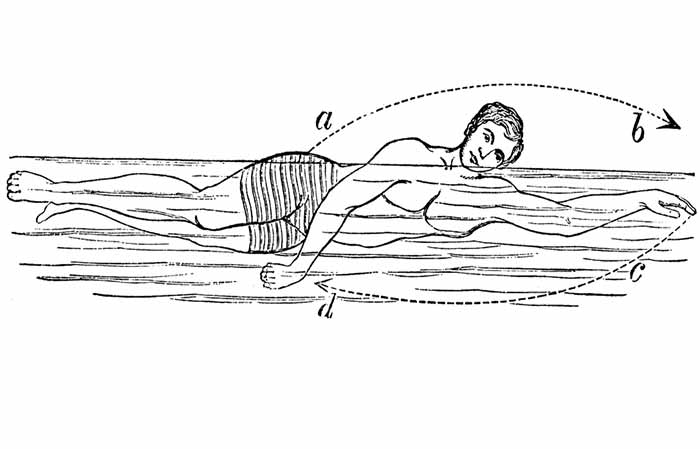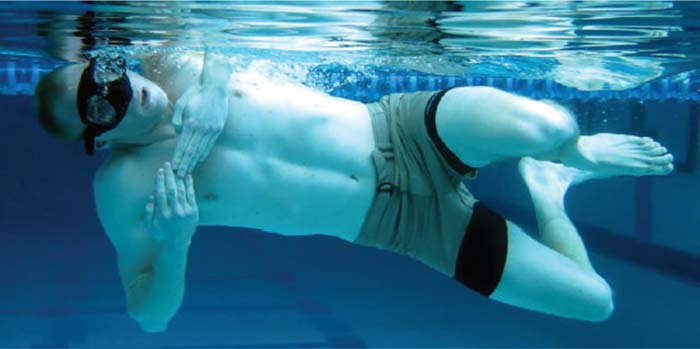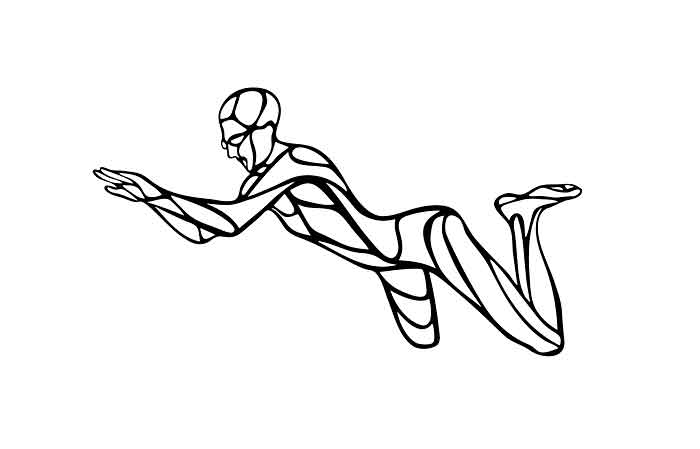How to Swim Sidestroke-Technique,Trudgen &Combat Drills & Tips
The sidestroke is a swimming style which occurs on one side as the other side rests. It’s a great swimming style to learn as it’s used often in saving lives and covering long distances. If you get injured on one side while swimming, for example, knowing how to do the sidestroke will be a great skill to have as it’ll likely save your life.
In the conventional sidestroke, the swimmer has their body on one side with the hand in the water doing more of the propulsion while the hand on top only moves to balance the body and propel the body minimally. The result is that one arm can work as the other one rests. When you’re tired, you simply switch to the fresh side. Also, the side swim allows for bigger and wider scissor kicks which generate more power than the flutter kicks in a typical down-facing swimming stroke.
The sidestroke has various variations including the combat sidestroke and the trudgen. These are hybrid styles borrowing from various styles one of which is the sidestroke. Their focus is to overcome some of the weaknesses of the sidestroke and make swimming more effective. The most efficient (yet most difficult) of these variations of the sidestroke is the combat sidestroke.
History
The earliest swimming styles were the freestyle and butterfly. With time, however, swimmers realized that turning your head to the side to breath was difficult and tiring especially for long distances. This was due to the tendency of the head to naturally move to the side.

In response, styles that required swimming on the side were brought up with the sidestroke emerging as the overall style on the side. It was later realized that, besides the better positioning of the head, the body was taxed less given the need to only use one side for the swim.
The trudgen sidestroke was developed by the English swimmer John Trudgen as a hybrid of the sidestroke and the freestyle. It overcame the weaknesses of both styles while giving the swimmer better speed. It is, however, harder to master given the unique way of doing the kicks and hand motions.

The combat sidestroke came about as a style that does it all. After years of studying swimming styles, the Naval Special Warfare Basic Training Command together with the Naval Special Warfare Preparatory School came up with a hybrid of the freestyle, sidestroke and breaststroke styles.

This style was focused on efficiency by which the swimmer would have the lowest profile in the water and could move even with a large package without difficulty. It’s the most difficult swimming style of the 8 known and taught.
Sidestroke Technique
The dominant feature of the sidestroke is the body being on the side rather than facing down or upwards. The arms are asymmetrical in their workings since their stroking isn’t the same. The scissor kick is its main source of propulsion power as it’s the widest swimming kick possible.
1. Body Position
All through the motions made by the hands and feet, the body remains on the side. The area from the hips to the shoulders remains perpendicular to the floor of the pool at all times. The only time the body moves is when you’re switching to the other side. You’ll thus move through 180°.
2. Arm Movements
While the arms will be moving in unison, they’ll be performing different types of movements. The upper arm will be doing almost a third of the movement done by the lower arm. The focus is to have the lower arm propel the body while the top arm balances it out.
The stroke starts with the arm under the body being extended forwards while the arm on top is resting on the side of your body. As the arm below pulls on the water to propel the body forward, the arm on top moves towards the chest area. The hands then meet at the chest to complete the first phase.
The second phase entails the arm below the body extending back to the starting point. The arm on top will push the water back from the chest area to the hip region. Essentially, it’s a recovery phase for both arms but the arm on top does a little stroke to lush you ahead.
3. Leg Movements
The primary leg movement for the sidestroke is the scissor kick. From a starting position of flat and extended feet, the leg on top goes forward at the hip as if slowly kicking forwards. The lower leg goes behind in its own slow kick. Both feet should slightly bend at the knees.
In the next phase, both feet snap together complete the scissor kick. Both legs should be pushing back on the water to push you ahead. The scissor kick shouldn’t be done with force. Rather, it should be done in a fluid yet powerful way to give you a jerk ahead. Forcing the kick increases drag on your body.
4. Breathing Technique
Being on your side at all times means that your head will alway be above the water. With the sidestroke, therefore, there’s little difficulty in breathing or straining your neck. The relatively slow motions from the hands and legs also ensure that very little water enters the nose to distract the swimmer.
To make the most of it, however, you need to synchronize your swimming with the strokes to move faster and breath more easily. You should ideally breath in tune with each hand stroke. As the lower arm pushes the water back and moves towards the chest, you inhale through your mouth. As the upper arm pushes back and returns to the hip area, you breath out through the mouth and nose.
5. Starting, Turning and Finishing
While the sidestroke isn’t a competitive stroke, the start, turn and finish techniques are all similar to the competitive styles such as the freestyle stroke. They entail jumping into the water face first, gliding for a while with hands stretched forwards then starting the stroke. The start can have a few flutter or dolphin kicks for the initial propulsion.
The start of the stroke requires turning on your side while leaving the hand below you outstretched forward. The hand on top comes to your side in preparation for the start of the stroke. At this stage, the feet will also turn with the rest of the body then start the first phase of the scissor kick.
When turning, the swimmer turns unto their stomach then touches the wall with both hands on a horizontal plane. As the body nears the wall, you bend your elbows then pull your legs under your body and towards the wall.
You then push against the wall with both hands to gain backwards momentum. However, your hands should leave the wall one at a time with the first hand to leave the wall getting stretched out ahead. It’ll act as the arm below the body.
As soon as the arms leave the wall, your feet will touch the wall to also push against it for momentum. The fact that your body by then will be already going to the side helps the feet go straight into the scissor kick motions a few moments after leaving the wall.
For a finish, both of your hands need to touch the wall at the same time and on a horizontal plane. This will require you to turn to your belly as you near the finish line.
Trudgen Sidestroke Technique
Looking at a swimmer perform the trudgen (or trudgeon) stroke, you will easily conclude that it’s a front crawl with a scissor kick.
Given that it’s difficult to perform the powerful scissor kick when on your belly, the trudgen stroke requires the swimmer to turn to their side to do the kick then return to their belly for the rest of the front crawl.
You’re essentially replacing the flutter kicks from the freestyle with the scissor kick from the sidestroke.
1. Body Position
The body will be moving from the side to the belly down. When on the side, you’ll be performing the scissor kick and gliding with the arm below you. As you turn on your belly, you’ll do the strokes for the freestyle swimming style until you turn to your side again for the scissor kick. Your head will mostly be out of the water hence making it easy to breath.
2. Arm Movements
The movement of the arms in the trudgen sidestroke are very similar to those of the freestyle stroke but with the glide of the sidestroke. Essentially, you’ll be using the crawl of the freestyle when your body turns to the belly but then glide with the arm below the body when you turn to your side.
On your belly, stroke with with the left hand then the right hand. As you turn to the left hand, the feet will do a scissor kick and you’ll glide with the left hand stretched forward through the water forwards. As the scissor kick ends and the feet go into recovery mode, stroke with the left hand then resume the crawl until you’re on your left side again for the glide.
3. Leg Movements
The legs are the most powerful propulsion tools you have for the trudgen sidestroke. This is because they perform the scissor kicks which send your body further ahead. When your body is on the side, you’ll do the scissor kick. This is done by opening up your legs on a horizontal axis like you’re running. You then snap them together with the final position being legs together with one above the other.
As you turn to your belly and perform the second stroke with your right hand, the feet will do a frog kick backwards. As you return to the left side, you’ll perform the scissor kick. Essentially, you’ll be doing the scissor kick every second stroke of the hands and from the same side until you switch sides.
4. Breathing Techniques
While the conventional sidestroke makes it quite easy to breath, the trudgen sidestroke is among the most difficult when it comes to breathing. The reason for this is that the face is almost always under the water making it tough to draw in air.
The only breathing window you have with this style is during the freestyle phase of the hands. As you turn on your belly and as the hand on top comes over the head to do the front crawl, your face will surface above the water just as your elbow passes in front of your face.
Given the breathing difficulty in this one, you should draw in as much air as you can as soon as the window appears. Breathing out can be done slowly underwater.
5. Starting, Turning and Finishing
The start, turn and finish movements for the trudgen sidestroke are similar to those of the conventional sidestroke. Basically, you start by gliding on your belly then turn on your side to perform the scissor kick then other strokes follow.
The turning requires turning to your belly or touch the wall and turn with both hands and feet pushing against the wall then resuming the strokes after a little glide. At the finish, both of your hands are needed to touch the wall at the same time and on a horizontal plane.
Combat Sidestroke Technique
The combat sidestroke is as complex as swimming gets. Developed to be the most efficient swimming style possible, this style requires a significant amount of time to grasp and use properly. However, like all styles, it too can be mastered with practice.
The style is a derivation of the sidestroke, freestyle and breaststroke styles. It makes you less visible, fast, and conserves your energy to cover long distances. It can also be used for when you’re carrying equipment and have to swim as well.
1. Body Movements
The body moves from the stomach to the side along an axis from your head to the middle of your hips. Your focus is to stabilize the body from a streamlined position through the strokes to the streamlined position again. If done right, your body will generate a lot of power forward and dissipate any sidewinding.
Most of the time, the body should just be below the water surface and only comes up with the arm stroke and for breathing. The reason for this is to reduce your profile on the water surface. Also, you’re faster stroking underwater than on the surface.
2. Arm Movements
With this style, none of your limbs should ever come out of the water. While the elbows peek on the surface for a while, the palms are not to come out.
From a flat profile where your arms are stretched forward and your palms face downwards, pull the left arm in a looping sweep downwards. The right arm shouldn’t move.
As the left elbow becomes perpendicular, turn to your right side and continue pushing the left palm towards your feet. This left palm should end at your groin area facing the body when you’re on your right side.
As soon as the left hand nears the groin area, let the right arm face downwards and start pushing water backwards as well. As the right arm loops towards the chest, the left arm should be in the recovery mode moving towards the chest as well.
The two hands meet at the chest when you’re on your side then go straight ahead together creating a streamlined upper body while on the side. As the feet complete the scissor kick, you turn on your side then start the stroke with the left hand again.
3. Leg Movements
Primarily, the legs perform the scissor and dolphin kicks in succession. The scissor kick occurs when you’re on your side while the dolphin kick is when you’re on your belly.
From a starting point of a streamlined profile with the feet together on a horizontal plane, you bring them towards your upper body but with one going back and the other one forwards in preparation for the scissor kick. The kick comes in as your hands move from the chest to the front together.
As you move to your belly again and start the strokes with the arms, you do the dolphin kick with both feet together. Ideally, the feet should touch at the toe tips for the best dolphin kick propulsion. After these kicks, the cycle resumes with the movements of the hands and feet.
4. Breathing Techniques
The breathing window is also very small in this one given the many maneuvers which occur under water. Also, given that there are various motions involved for a single cycle, you need to breath in with every window you get.
The breathing window comes when the first arm on the cycle has finished the pull cycle and is close to the groin area. The head is at its highest but only appears briefly above the water. At this stage, your body has turned fully to your side and the head can thus appear above the water briefly.
5. Starting, Turning and Finishing
The starting position for the combat sidestroke is similar to the freestyle in that you jump into the water face first, glide for a while while doing dolphin kicks before starting to stroke the water.
At the turning point, you reach out to the wall with both hands, press yourself against it then turn on one side before gliding for a while. After that, you resume the stroke. The finishing is similar to the turn in that you’re required to touch the wall with both hands on a horizontal plane.
Drills and Tips
Given that all of the styles in this list re variations of the sidestroke, these tips apply to all of them.
- Keep your body as flat as possible.
This applies to the torso in that you should avoid bending the hip region whether on your side or on a horizontal plane. Bending this region makes you bigger in the water hence giving you a higher drag.
- Synchronize your with breathing your strokes
This allows you focus on your strokes better. Panting and breathing frantically will distract you from the fluid motion of the strokes.
- Learn the parts of the strokes independently
Before embarking on the strokes as they are in full, you need master each part of their movements then combine them.
One of the hardest parts has been the scissor kick. As it’s performed on the side, one needs to have mastered aspects such as various floating styles and how to switch positions in the water. You can do the moves in water or outside for a start.
- Learn the strokes before learning speed
Once you master the strokes in the correct way and order, you can then learn how to perform them faster to gain speed.
Most importantly, learning the hybrid styles such as combat sidestroke and the trudgen sidestroke requires that you master each of their individual styles for the best results. For example, you’ll need to master the freestyle, breaststroke and sidestroke to learn the combat sidestroke.
Benefits and Advantages of the Sidestroke
Among the benefits of learning these sidestroke variations include the following:
- The fact that these styles offer easier breathing makes them the easy for those who haven’t perfected breathing techniques.
- The sidestroke is widely used as a rescue technique since it allows for carrying an extra load when swimming.
- Given that it relatively uses less energy, it’s suited for long-distance swimming.
While not a competitive stroke, the sidestroke finds use in many different areas from the military to lifeguards and beyond.
Sidestroke Disadvantages
The main downsides to the sidestroke and its variations include the following:
- It’s not used in competitions mainly due to the many ramifications and slow speeds.
- It can be quite difficult to learn especially the hybrid ones.
Even with these disadvantages, the sidestroke style and its derivatives are among the most practical styles in swimming.
Further Reading
Following is a list of articles with more swimming information and other water sports
Swimming Strokes/Styles
- Different Types of Swimming Strokes, Styles & Names
- What is Sculling in Swimming? How to do it
- How to Tread Water- Techniques, Benefits & Exercises
- How to Swim Freestyle: Technique, Tips & Drills
- How to Swim Breaststroke: Kick, Pull, Form, Drills & Tips
- Butterfly vs Breaststroke Swimming
- How to Swim Elementary Backstroke- Technique, Drills & Tips
- How to Swim Backstroke-Technique, Drills & Tips
- How to Swim Butterfly: Technique, Drills & Tips
Swimming FAQs & Ideas
- How Many Calories Does Treading Water Burn?
- Can you Swim with Contacts in the Ocean/Pool?
- Can you Open your Eyes in the Salty Ocean or Chlorinated Pool Waters?







